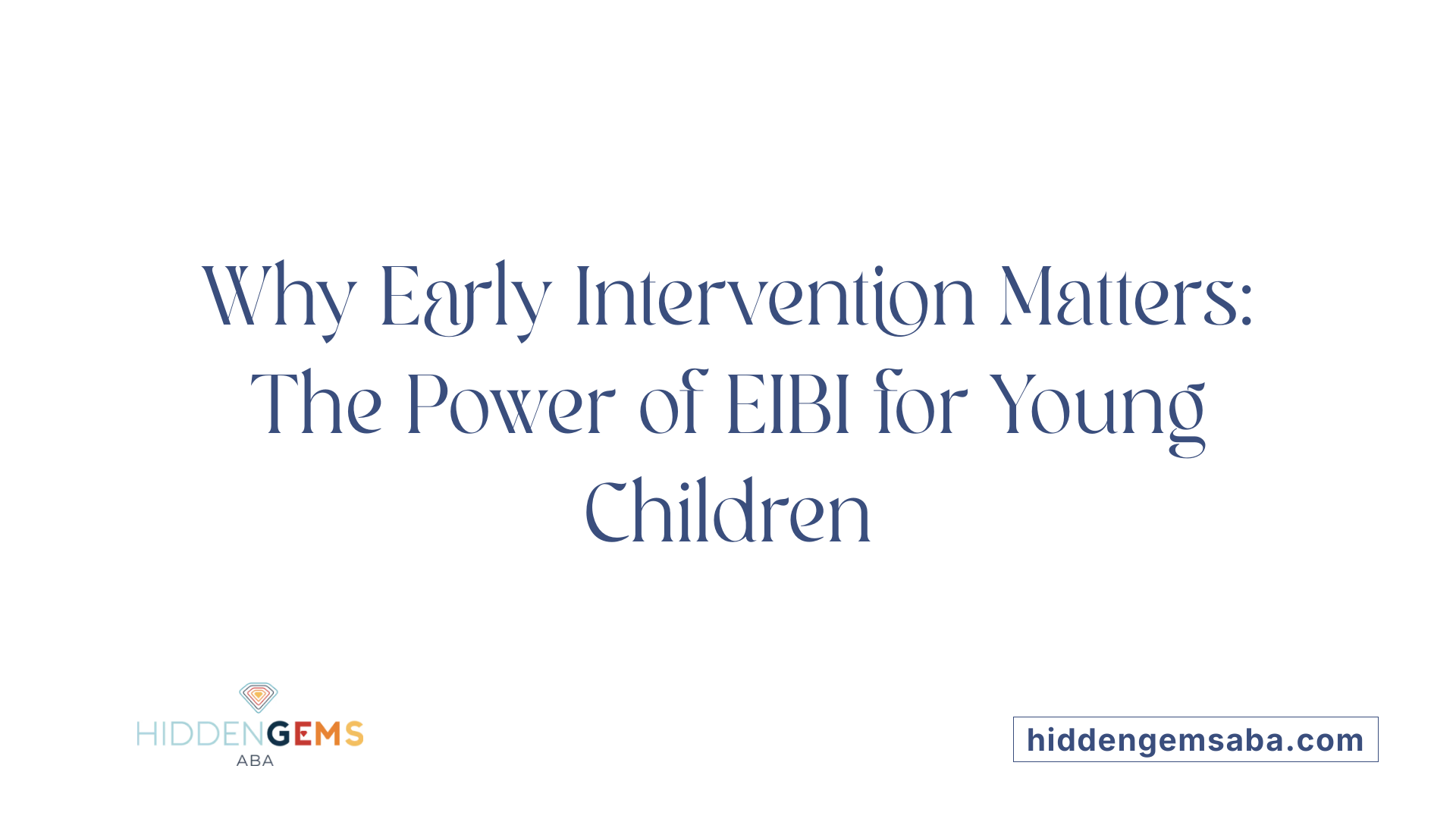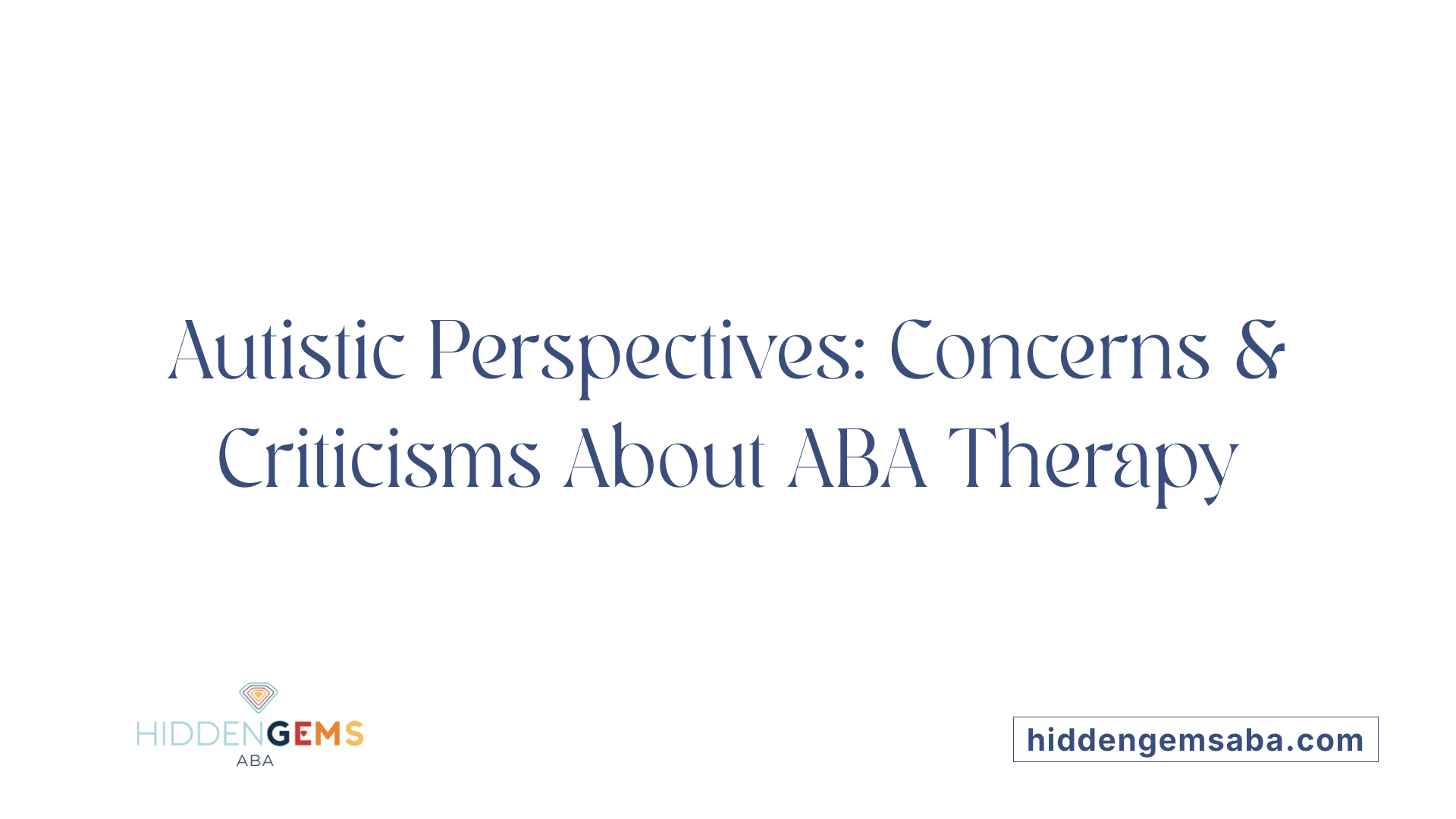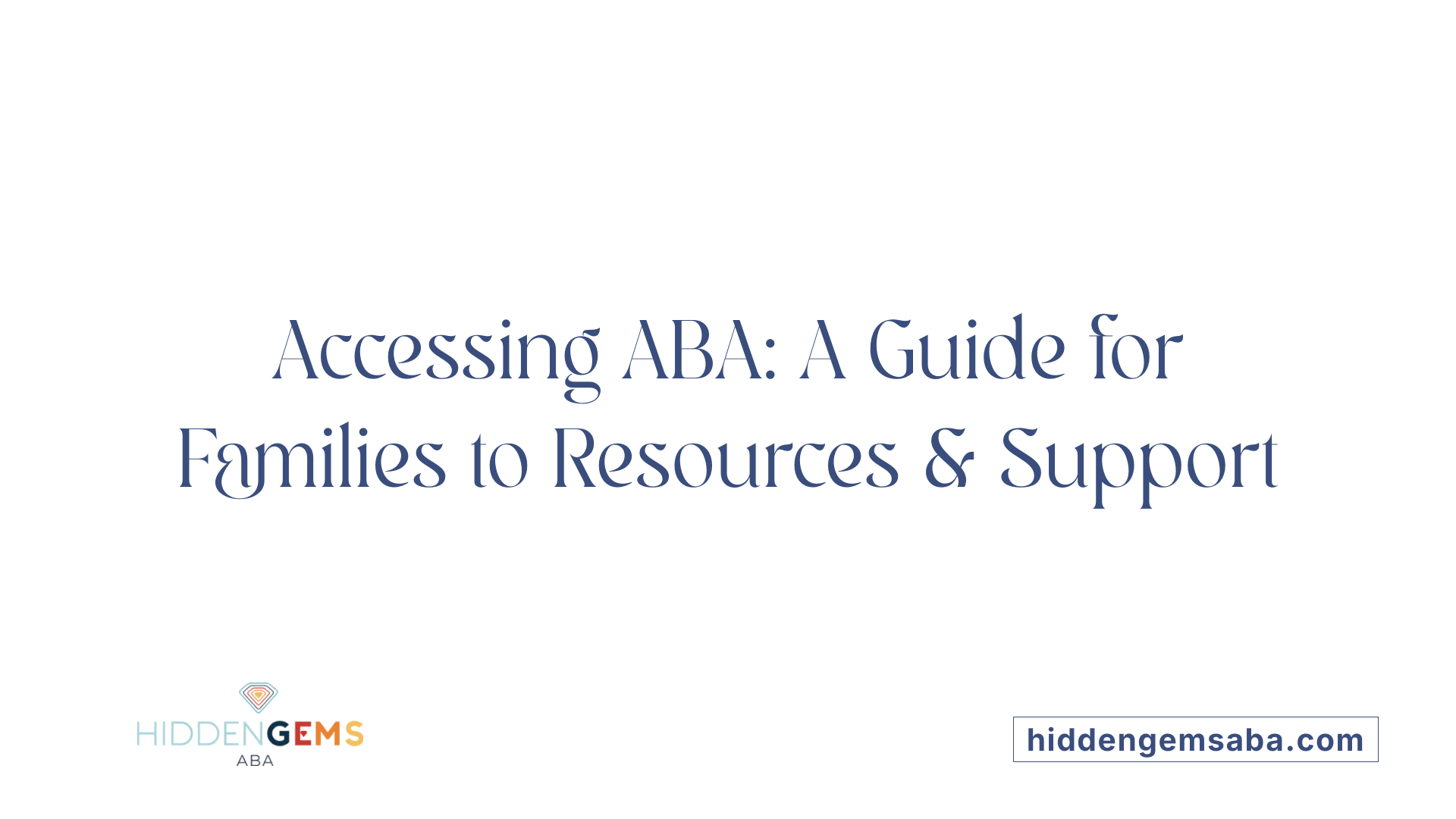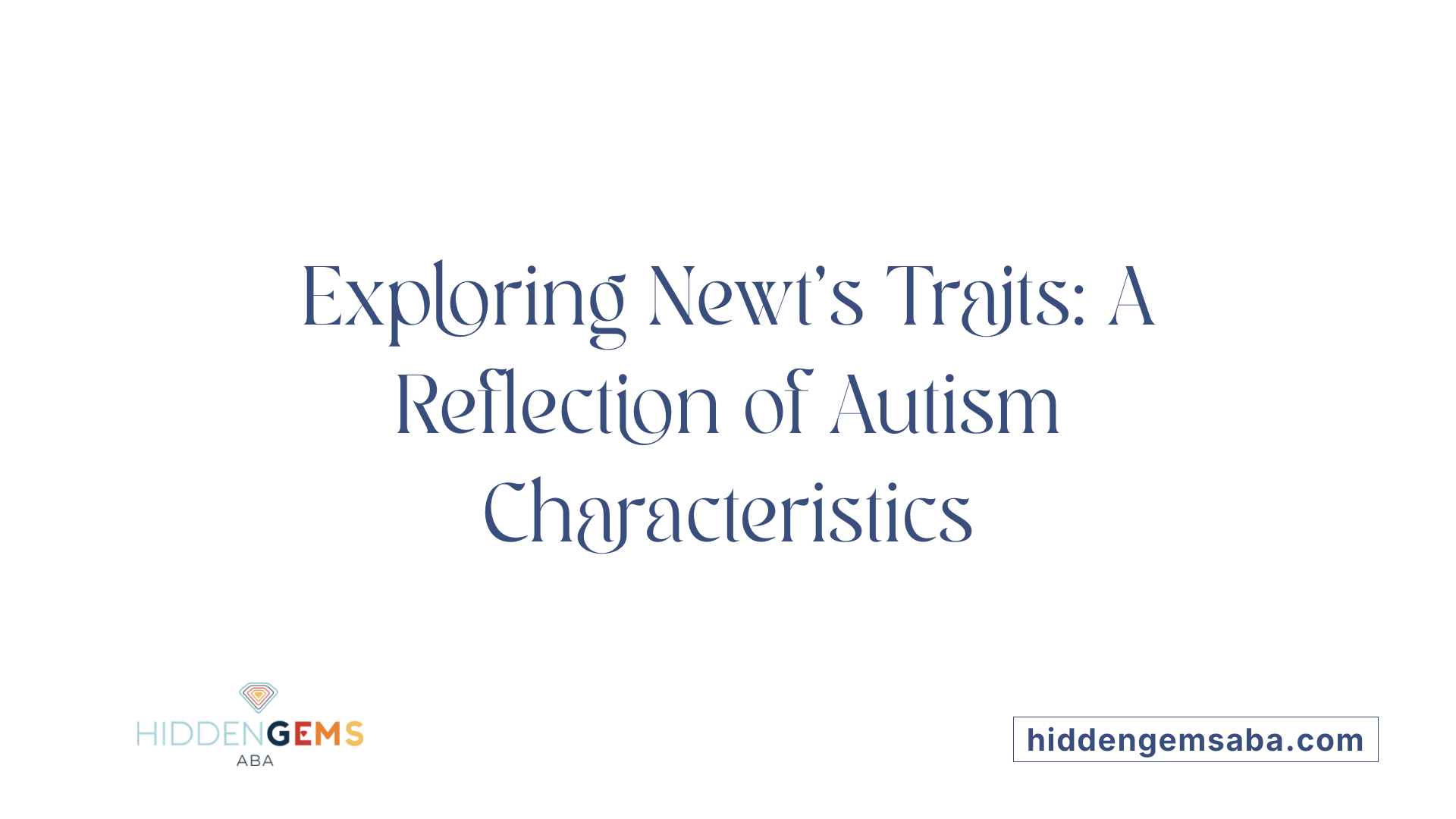Is Newt Scamander a Portrayal of Autism?
The character of Newt Scamander, beloved in the Wizarding World, has sparked discussion around whether his traits align with those commonly associated with autism spectrum disorder (ASD). This article delves into the characteristics of Newt Scamander in context with what we understand about autism and the therapies designed to support individuals on the spectrum, particularly Applied Behavior Analysis (ABA) therapy.
Understanding ABA Therapy and Its Foundations
What is Applied Behavior Analysis (ABA) therapy and how does it help individuals with autism?
Applied Behavior Analysis (ABA) therapy is a science-based approach that uses principles of behaviorism to help individuals with autism spectrum disorder (ASD) develop socially significant skills and reduce challenging behaviors. ABA relies on methods like reinforcement and conditioning to encourage positive behaviors while decreasing those that interfere with learning or functioning.
The goals of ABA therapy include improving communication, social interactions, intellectual abilities, and adaptive living skills in autistic individuals. Practitioners use carefully designed interventions that are individualized to each person's needs, continually assessing progress and adjusting strategies accordingly. By focusing on these targeted behaviors, ABA seeks to foster meaningful developmental gains that enhance everyday functioning.
ABA therapy encompasses various techniques, both structured and naturalistic. For example, Early Intensive Behavioral Intervention (EIBI) applies ABA principles intensively — often 25 to 40 hours per week — especially for young children under 3 years old, resulting in strong improvements in language and cognitive skills during critical developmental windows.
The underlying principle involves shaping behavior through positive reinforcement, which can be particularly helpful in autism where difficulties in areas like joint attention and theory of mind may hinder natural language development. ABA offers alternate routes to skill acquisition by establishing desired behaviors directly through reinforcement, bypassing some challenges posed by these social-cognitive difficulties.
In essence, ABA therapy is a systematic effort to support autistic individuals in acquiring a broad array of functional skills, aiming to improve quality of life by promoting independence and social engagement.
Who Provides ABA Therapy? Qualifications and Roles
Types of professionals providing ABA therapy
ABA therapy is delivered by a team of professionals with expertise in behavioral analysis and autism support. This team typically includes Board Certified Behavior Analysts (BCBAs), Board Certified Assistant Behavior Analysts (BCaBAs), and Registered Behavior Technicians (RBTs). BCBAs serve as the lead specialists who design and oversee individualized treatment plans, while BCaBAs assist in implementing interventions and may supervise RBTs. RBTs, often the primary therapists interacting with clients, carry out day-to-day therapy sessions based on these plans.
Qualifications and certifications required
Professionals providing ABA therapy usually have advanced education and certification in behavior analysis. BCBAs and BCaBAs hold credentials granted by the Behavior Analyst Certification Board (BACB) after meeting rigorous academic requirements, supervised fieldwork, and passing certification exams. Most possess a master's degree in psychology, education, or applied behavior analysis. RBTs complete specialized training and competency assessments but do not require a college degree. These certifications ensure that therapists have a standardized level of knowledge concerning ABA principles and ethical practices.
Role of therapists and supervision
Therapists administer ABA interventions emphasizing reinforcement and behavior conditioning tailored to individual needs. The BCBA develops treatment goals based on client assessments and continuously supervises therapy to evaluate progress and make adjustments. Trained therapists, including RBTs, provide hands-on therapy under this expert guidance, ensuring consistent, effective application of techniques. This supervisory hierarchy ensures quality control and adaptation of therapy to maximize benefits while minimizing potential harm.
Common Techniques Used in ABA Therapy for Autism

What are the common techniques used in ABA therapy for autism?
ABA therapy employs several structured and naturalistic techniques to support skill learning and behavior change in autistic individuals.
Discrete Trial Training (DTT) breaks down skills into small, teachable components, using repeated trials to build mastery. DTT is highly structured, often involving a clear beginning and end to each teaching moment.
Natural Environment Teaching takes place in everyday settings, helping individuals learn skills within contexts they naturally encounter. This approach encourages generalization of skills beyond the therapy setting.
Positive reinforcement plays a central role by rewarding desired behaviors to increase their frequency. Rewards might include praise, tokens, or preferred activities.
Prompting and fading involve providing cues or assistance to evoke correct responses initially, then gradually reducing help to promote independence.
Visual modeling uses videos, pictures, or demonstrations to show appropriate behaviors or communication ways. This supports learners who benefit from visual information.
Throughout all these methods, data collection is critical. Clinicians carefully track responses and progress to adjust teaching strategies and ensure effective outcomes.
Together, these techniques form a comprehensive toolbox in ABA therapy, tailored to meet the diverse needs of autistic individuals in building communication, social, and adaptive skills.
Evidence Supporting ABA's Effectiveness in Autism Treatment
What evidence supports the effectiveness of ABA therapy in treating autism spectrum disorder?
Applied Behavior Analysis (ABA) therapy has been extensively researched and is shown to significantly enhance social, communication, and daily living skills in individuals with autism spectrum disorder (ASD). Meta-analyses and systematic reviews consolidate findings from numerous studies, highlighting improvements in intellectual abilities, language skills, communication, social behavior, and adaptive living skills when ABA is employed.
One notable approach, Early Intensive Behavioral Intervention (EIBI), involves applying ABA techniques for 25 to 40 hours per week, primarily targeting children under three years old. Research demonstrates that such early and intensive intervention leads to substantial development in language and cognitive skills, providing a strong foundation for later learning and social engagement.
ABA research often uses rigorous statistical methods to validate outcomes. For example, multivariate analyses like MANCOVA have confirmed that children receiving ABA show measurable progress in adaptive behaviors, social skills, and emotional regulation. Studies utilizing validated assessment tools such as the Kindergarten Inventory of Social/Emotional Tendencies (KIST) provide empirical support for these improvements.
Parental involvement and generalization of learned behaviors to natural environments are crucial factors contributing to treatment success. Interventions that promote skill application beyond therapy sessions tend to yield longer-lasting effects.
This body of evidence underscores ABA's value as an effective behavioral intervention in managing ASD, particularly when initiated early and delivered intensively.
Early Intensive Behavioral Intervention: Critical for Young Children

What is Early Intensive Behavioral Intervention (EIBI)?
Early Intensive Behavioral Intervention (EIBI) is a structured therapy approach based on Applied Behavior Analysis (ABA). It involves intensive, one-on-one behavioral therapy sessions typically lasting between 25 to 40 hours per week. The goal of EIBI is to enhance the development of socially significant behaviors by using reinforcement and conditioning principles.
How effective is EIBI for children under 3 with ASD?
Research consistently shows that EIBI is highly effective for children under the age of three diagnosed with Autism Spectrum Disorder (ASD). This early timing is crucial because it leverages the brain's plasticity during a sensitive developmental window. Implementing EIBI at this stage has been linked to significant improvements in various developmental areas.
What skills does EIBI focus on developing?
EIBI primarily targets the development of language and cognitive skills. Given that many autistic children face challenges such as difficulties with joint attention and theory of mind, which can hinder traditional language acquisition routes, EIBI uses alternative strategies rooted in behavior reinforcement to build these skills. Through consistent and intensive therapy, children often display improvements not only in communication but also in cognitive functioning that benefits daily living and social interaction.
Challenges Faced by Autistic Individuals Affecting Therapy
What Are Theory of Mind and Joint Attention, and How Do They Affect Language Development?
Autistic children often experience difficulties with theory of mind, which is the ability to understand others' thoughts and feelings, and joint attention, the shared focus on an object or event with another person. These challenges can significantly impede language development because both skills are foundational for effective communication and social interaction.
How Do These Difficulties Impact Language Acquisition?
Without a well-developed theory of mind, children may struggle to grasp the intent behind language or the subtle cues used in communication. Similarly, joint attention issues make it hard for children to engage in interactive communication that fosters language learning. As a result, traditional social routes to language acquisition might not be as effective for autistic individuals.
How Can ABA Address These Challenges?
Applied Behavior Analysis (ABA) offers alternative pathways to build language skills by focusing on reinforcement of desired behaviors rather than relying solely on social-cognitive development. By systematically encouraging communication behaviors through conditioning, ABA can effectively bypass some of the obstacles posed by difficulties in theory of mind and joint attention.
What Are Some Specific Approaches in ABA?
Early Intensive Behavioral Intervention (EIBI), a form of ABA delivered intensively over 25 to 40 hours per week, has been shown to be particularly effective for young children under three years with ASD. EIBI emphasizes the development of language and cognitive skills through structured reinforcement strategies.
Through these methods, ABA aims not just to improve language but also to support adaptive behaviors that help autistic individuals engage more successfully with their environment.
Concerns and Criticisms Within the Autistic Community About ABA

What are the perceptions of ABA's deficit model?
Many autistic individuals and advocates express concern that ABA therapy is grounded in a deficit model. This model views autism chiefly as a set of behaviors to fix rather than as a natural variation of human neurology. Within this framework, ABA is sometimes seen as aiming to make autistic people appear more "allistic" (non-autistic), valuing conformity over authenticity. This approach can contribute to feelings of erasure and pressure to hide one's true identity.
How does ABA impact natural behaviors like stimming?
Stimming, or self-stimulatory behavior, is a common and meaningful activity for many autistic individuals, helping them manage sensory input and emotional states. Critics argue that ABA often targets these behaviors for reduction or elimination, interpreting them as problematic. However, suppressing stimming can remove an important coping mechanism and increase stress, contradicting the therapy's goal of improving well-being.
Could ABA suppress important self-regulation mechanisms?
Because some ABA techniques prioritize reducing visibly autistic behaviors, there is concern this can lead to the suppression of essential self-regulation strategies. When autistic traits are masked or camouflaged, individuals may experience increased anxiety, depression, and lower self-esteem. This impact on mental health highlights the need for approaches that respect natural autistic behaviors rather than attempting to erase them.
Efforts to revise ABA practices include trauma-informed care and incidental training methods, aiming to honor individual differences and support naturalistic learning. These modifications seek to make therapy less harmful and more supportive of autistic individuals' authentic selves.
Mental Health Implications of Social Skill Focus in ABA
How does camouflaging and masking of autistic traits occur in ABA?
Applied Behavior Analysis (ABA) often emphasizes developing social skills by encouraging behaviors that align with neurotypical social norms. This focus can lead some autistic individuals to camouflage or mask their natural autistic traits to fit in better socially. Such masking involves consciously or unconsciously suppressing behaviors like stimming or avoiding eye contact, which are important for self-regulation and comfort.
What are the risks of anxiety, depression, and low self-esteem from masking?
Research shows that consistent masking can have significant mental health consequences. The effort to hide authentic behaviors often results in increased anxiety and depression. Moreover, the suppression of natural coping mechanisms can lower self-esteem, contributing to emotional distress. These negative outcomes highlight a potential drawback of social skill training that prioritizes neurotypical behavior over individual comfort and identity.
What considerations should be made for therapeutic approaches?
Given the risks associated with masking, therapists are encouraged to adapt ABA interventions. Modifications such as incidental teaching and trauma-informed care focus on supporting naturalistic socialization and language acquisition without forcing behavioral conformity. These approaches prioritize the autistic person's well-being and aim to reduce trauma exposure during therapy, making treatments more respectful of individuality and mental health needs.
Limitations and Controversies in ABA Research and Practice
What are the inconsistencies in research evidence on ABA?
While many studies support ABA's benefits in improving skills for individuals with ASD, some research shows inconsistencies. Not all studies report strong or lasting improvements, and meta-analyses highlight variability in outcomes. This disparity suggests that ABA's effectiveness may depend on individual factors and how the therapy is applied.
What limitations exist in some ABA studies?
Several ABA studies face methodological limitations such as small sample sizes, lack of control groups, and short follow-up periods. These factors can reduce the reliability and generalizability of their findings. Additionally, many studies focus on narrowly defined outcomes without considering broader wellbeing or mental health impacts.
Are there questions about ABA's overall justification?
Given the mixed evidence and critiques from the autistic community, questions arise about whether ABA fully justifies its widespread use. Concerns about potential harm, including the suppression of natural behaviors and mental health consequences, add to the debate. This underscores the importance of refining ABA approaches and integrating more individualized, supportive methods to better meet autistic individuals' needs.
Advances in ABA: Trauma-Informed and Individualized Approaches
What modifications have been made to traditional ABA?
Traditional Applied Behavior Analysis (ABA) is evolving with modifications aiming to better meet the needs of autistic individuals. One such change is the incorporation of incidental teaching, which focuses on learning through natural interactions and daily activities instead of rigid, repetitive drills. This approach seeks to foster skill development in a way that feels more engaging and less forced.
How do trauma-informed practices influence ABA?
Trauma-informed ABA recognizes the potential for traditional interventions to cause distress or reinforce negative experiences. By integrating trauma sensitivity, therapists are more attentive to the emotional states of autistic individuals, ensuring that intervention strategies do not replicate or trigger trauma. This change promotes a more respectful and supportive therapy environment, reducing the risk of adverse effects such as anxiety or depression caused by pressure to conform to neurotypical standards.
What is naturalistic language acquisition in this context?
Naturalistic language acquisition emphasizes developing communication skills through everyday situations, social interactions, and meaningful contexts. This method contrasts with earlier ABA models that often used structured prompts and reinforcement. By encouraging spontaneous language use within natural settings, therapy aligns better with how children typically learn to speak and engage, fostering more authentic communication abilities.
How are therapies aligning with individual needs?
Modern ABA approaches prioritize personalization by respecting each person’s unique experiences, preferences, and coping mechanisms. Instead of enforcing uniform behaviors, therapists focus on promoting strengths and supporting autonomy. This alignment reduces the pressure to mask autistic traits and acknowledges the importance of behaviors like stimming for self-regulation.
These contemporary developments in ABA demonstrate a shift from a one-size-fits-all model toward flexible, compassionate interventions that consider both mental health and personal dignity while aiming to facilitate meaningful growth.
How Families Can Access ABA Therapy Services

Referral processes
Families seeking ABA therapy for their loved ones diagnosed with autism typically start by consulting healthcare professionals or autism specialists. These experts can provide referrals to qualified ABA providers, ensuring the therapy is appropriate and targeted to the individual's needs.
Insurance coverage including Ryan’s Law and Medicaid
In South Carolina, special provisions like Ryan’s Law provide insurance coverage for ABA therapy for children diagnosed with autism up to age 8, with benefits extending up to age 16. Ryan’s Law guarantees a minimum annual benefit of $50,000 for these services. Additionally, Medicaid covers ABA therapy for approved individuals, generally requiring a doctor's prescription.
Assessing insurance benefits
Families should carefully review their insurance policies to understand the extent of ABA therapy coverage. Since the PDD Waiver no longer accepts new applications, families need to evaluate current Medicaid plans and private insurance options to find the best support.
Selecting qualified providers
Choosing reputable providers with certified behavior analysts is vital. Qualified professionals can deliver evidence-based ABA therapy tailored for the individual, improving outcomes and ensuring ethical standards.
Importance of developing tailored treatment goals
Collaborating with healthcare providers to create personalized treatment goals is critical. Tailored plans should focus on developing social, communication, and adaptive skills in ways that respect the individual's unique needs and preferences.
The process of accessing ABA therapy involves a combination of informed referrals, understanding insurance entitlements, careful provider selection, and goal-oriented therapy planning to support positive developmental outcomes for individuals with autism.
Examining Newt Scamander's Traits Through the Lens of Autism
What is ABA and How Does It Help People with Autism?
Applied Behavior Analysis (ABA) is based on behaviorism principles like reinforcement and conditioning. It helps develop socially important behaviors and reduce challenging ones in autistic individuals. By rewarding desired behaviors, ABA encourages skills in communication, social interaction, and everyday living.
What Evidence Shows ABA's Benefits?
Research including meta-analyses and reviews suggests ABA can improve intellectual abilities, language skills, communication, social behavior, and adaptive living skills for individuals with autism spectrum disorder (ASD). Early Intensive Behavioral Intervention (EIBI), a form of ABA involving 25 to 40 hours per week for children under 3 years old, is particularly effective at enhancing language and cognitive abilities.
Why is ABA Useful for Language Development in Autism?
Autistic children often experience difficulties with theory of mind and joint attention, which are important for language learning. ABA may bypass these challenges by creating alternative learning routes using reinforcement, establishing new language-related behaviors even when typical social cues are hard to process.
What Concerns Exist About ABA from the Autistic Community?
There are worries that ABA is rooted in deficit models aiming to make autistic individuals more "allistic" or non-autistic. This can lead to suppression of natural behaviors like stimming, which many autistic people use for self-regulation and coping.
What Are the Mental Health Risks Associated with ABA?
Some studies indicate social skills training in ABA might promote camouflage or masking of autistic traits, potentially resulting in anxiety, depression, and lower self-esteem over time.
Are There Limitations in ABA Research?
Critics highlight inconsistent or limited evidence in demonstrating significant improvements from ABA, questioning its broad justification as a treatment.
How Can ABA Be Modified to Address These Concerns?
Adjustments like incidental training and trauma-informed approaches aim to make ABA less distressing and more tailored to individual needs. These changes encourage more naturalistic acquisition of language and socialization skills without enforcing conformity to non-autistic societal norms.
Does Newt’s Behavior Reflect Common Autism Characteristics?

Challenges with social communication
Newt Scamander's difficulty in engaging with typical social interactions can be seen as reflecting traits often observed in autistic individuals. He tends to avoid eye contact and struggles with interpreting social cues, which aligns with the challenges in social communication that many autistic people face.
Unique coping mechanisms
Newt displays distinct coping methods such as his intense focus on magical creatures and his preference for solitude. These behaviors resonate with autistic individuals' uses of specialized interests and routines to self-regulate and manage sensory or emotional overload.
Sensitivity and preference for solitude
His discomfort in crowded or highly stimulating environments and preference for spending time alone with creatures suggest heightened sensory sensitivity and a need for solitary reflection. Both traits are characteristic of many on the autism spectrum.
Evidence from character portrayal
Throughout the portrayal, Newt exhibits behaviors such as stimming-like movements and an emphasis on routines, which may serve as self-soothing mechanisms. Such traits support the interpretation that his behavioral profile includes key elements seen in autistic individuals, making his character a representative depiction of common autism characteristics.
The Role of Therapy in Supporting Characters Like Newt
Potential benefits of ABA-style interventions
Applied Behavior Analysis (ABA) relies on behaviorism principles such as reinforcement and conditioning to encourage socially significant skills and reduce challenging behaviors. Meta-analyses show ABA can help improve intellectual abilities, language, communication, social behavior, and adaptive living skills for individuals with autism spectrum disorder (ASD). Early Intensive Behavioral Intervention (EIBI), a form of ABA delivered extensively to children under 3, has proven especially effective in developing language and cognitive skills by providing consistent, structured learning.
Respecting individuality and neurodiversity
Despite its benefits, ABA has faced criticism from the autistic community for aiming to make autistic individuals appear more neurotypical, often overlooking autistic identity and strengths. Many autistic people and advocates stress the importance of valuing neurodiversity — recognizing and respecting different ways of thinking and behaving rather than trying to "normalize" them.
Avoiding suppression of coping mechanisms
Certain behaviors like stimming, which ABA sometimes seeks to reduce, actually serve important roles in self-regulation and coping. Suppressing these can negatively impact mental health and well-being. Furthermore, therapy approaches that encourage social skill development may inadvertently encourage masking or camouflaging autistic traits, leading to anxiety, depression, or low self-esteem.
Holistic approaches to development
To better support characters like Newt, therapy methods can incorporate modifications such as incidental teaching and trauma-informed practices. These focus on naturalistic learning and individual needs, reducing distress and enhancing socialization and language acquisition organically. Such balanced approaches recognize the value of fostering skills while honoring each person’s unique identity and experiences.
Why Representation Matters: Understanding Autism Through Fictional Characters
What Is ABA and How Does It Work?
Applied Behavior Analysis (ABA) uses principles from behaviorism, such as reinforcement and conditioning, to encourage positive social behaviors and reduce challenging ones in autistic individuals. By focusing training on observable behaviors, it aims to build practical skills essential for daily life.
What Evidence Supports ABA's Effectiveness?
Multiple meta-analyses and systematic reviews show that ABA interventions can lead to improvements in various areas, including intellectual functioning, language, communication capabilities, social interactions, and adaptive living skills for people with autism spectrum disorder (ASD).
How Does Early Intensive Behavioral Intervention Help?
Early Intensive Behavioral Intervention (EIBI) is a form of ABA delivered intensively, often 25 to 40 hours a week, typically targeting children younger than three years. This approach has shown significant success in advancing language and cognitive abilities during critical early developmental stages.
How Does ABA Address Language Challenges?
Autistic children often face difficulties with theory of mind and joint attention, which are important for natural language development. ABA therapy can work around these challenges by establishing alternative behavioral pathways through reinforcement, thus fostering language acquisition even when typical developmental routes are impaired.
What Are Some Concerns About ABA?
Some members of the autistic community feel that ABA is rooted in a deficit-based model aiming to make autistic individuals appear "more typical." This can involve suppressing natural behaviors like stimming, which many use to self-regulate. Additionally, focusing intensely on social skill development may encourage camouflaging or masking autistic traits, potentially leading to negative mental health consequences such as anxiety and depression.
How Is ABA Being Adapted to Be More Supportive?
To address these concerns, adaptations like incidental training and trauma-informed approaches have emerged. These methods seek to make ABA less stressful and more tailored to individual needs, promoting more naturalistic language learning and socialization experiences without compromising emotional well-being.
| Aspect | Description | Additional Notes |
|---|---|---|
| ABA Principles | Reinforcement and conditioning to shape behaviors | Emphasizes observable behavior changes |
| Benefits | Gains in language, communication, cognition, and adaptive skills | Supported by meta-analyses and reviews |
| EIBI | Intensive ABA for children under 3 | Hours per week range from 25 to 40 |
| Language Development Challenges | Difficulties with theory of mind and joint attention | ABA offers alternative learning routes |
| Community Concerns | Possible suppression of natural autistic behaviors | Risk of mental health issues from masking behaviors |
| Adaptations | Incidental training and trauma-informed methods | Aim to reduce trauma and increase natural engagement |
Balancing Strengths and Challenges: Insights From Newt’s Persona
Celebration of Unique Talents and Skills
Newt's persona highlights the importance of recognizing and valuing the diverse talents that autistic individuals often possess. ABA therapy supports the enhancement of intellectual abilities, language, communication, social behavior, and adaptive living skills. Such growth can help reveal and amplify these strengths, allowing autistic people like Newt to thrive in various environments.
Acknowledging Social or Sensory Challenges
Autistic individuals frequently face challenges related to theory of mind and joint attention, which can complicate language development and social interactions. Newt's experiences exemplify how these difficulties may impact daily life. While ABA offers structured techniques to bypass some of these hurdles via reinforcement and conditioning, it sometimes requires a careful approach to avoid unintentional suppression of important behaviors.
Emphasizing Strengths Rather Than Deficits
Focusing solely on overcoming difficulties risks overlooking the unique ways autistic individuals express themselves. Concerns from the autistic community, reflected in Newt’s perspective, emphasize that therapies aiming to normalize behavior might inadvertently encourage masking or camouflaging traits. This can contribute to negative mental health outcomes such as anxiety and lowered self-esteem. Therefore, balancing ABA's use with trauma-informed, naturalistic, and strength-based methods promotes well-being by enhancing communication and social skills while respecting individuality and coping mechanisms like stimming.
Future Directions in Autism Support and Therapy
Innovations in ABA and Alternative Treatments
Applied Behavior Analysis (ABA) remains a prominent therapy for autism, particularly through methods like Early Intensive Behavioral Intervention (EIBI). However, the future promises new approaches that address current criticisms while retaining effective outcomes. Modifications such as incidental training, which integrates learning into natural environments, and trauma-informed care are gaining attention. These adaptations aim to reduce the potential for trauma in therapy and cater more closely to individual needs.
Importance of Individualized, Trauma-Informed Care
Moving forward, autism support emphasizes personalized care that respects each individual's unique profile and preferences. Trauma-informed ABA approaches avoid harsh or purely corrective techniques, focusing instead on building skills without suppressing important self-regulatory behaviors like stimming. This shift helps create a therapeutic environment that supports not only skill acquisition but also emotional well-being.
Promoting Mental Health Alongside Skill Development
Recognizing that some ABA techniques can unintentionally lead to camouflaging or masking autistic traits, which may cause anxiety and depression, future therapies will be designed to support mental health concurrently with social and communication skills. Balancing the development of adaptive behaviors with respect for neurodiversity is increasingly seen as essential. This holistic outlook aims to promote self-esteem and long-term emotional resilience while improving intellectual and language abilities.
Reflections on Newt Scamander and Autism Awareness
While Newt Scamander is a fictional character, his distinctive traits invite meaningful conversation about autism and the lived experience of those on the spectrum. Understanding ABA therapy’s role, benefits, and controversies helps illuminate how support can be tailored to promote genuine development without compromising individuality. Through characters like Newt, society gains opportunity to explore neurodiversity, celebrate unique qualities, and advocate for compassionate therapies that respect the needs and strengths of autistic individuals.
References
- aba: clinical efficacy & autistic perspectives
- ABA Techniques: Strategies for Behavior Analysts - GSEP Blog
- Applied Behavior Analysis (ABA)
- Applied Behavior Analysis (ABA)
- The effectiveness of applied behavior analysis program ...
- 6 Benefits of ABA Therapy for Children with Autism
- Applied Behavior Analysis (ABA)






